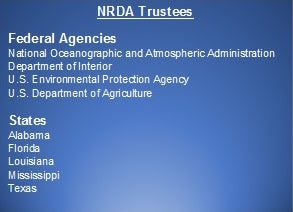The Science of the Spill
By Alisha Renfro, Coastal Scientist, National Wildlife Federation
The blow out of the Macondo well claimed 11 lives and began the largest marine oil spill in U.S. history. It took 87 days to finally cap the well and by then at least 134 million gallons of crude oil had been expelled into the Gulf of Mexico.
With the source of the oil nearly a mile below the surface of the water and at four times the size of the Exxon Valdez, the BP oil disaster presented many new challenges. The experience and response methods used in previous oil spills was often found to be impossible to apply or ineffective. As a result, scientists began scrambling to measure how much oil was leaking from the well, tracking and predicting where it would go and trying to understand what this spill would mean for the people, wildlife and habitat of the Gulf.
While large amounts of scientific data have been collected and published in peer-reviewed journals in the five years since the oil spill, more scientific research is still ongoing. The science related to the spill has been largely funded through a few different sources, including:
The NSF has scientific funding available to address pressing research needs during unanticipated events, like the BP oil spill. The availability and flexibility of this funding source allowed scientists receiving this grant to quickly mobilize and collect important data that may have otherwise been missed in the confusion in the days after the spill when oil was still gushing out of the wellhead.
In May-2010, BP dedicated $500 million over 10 years to independent scientific research to investigate the oil spill impacts on the Gulf of Mexico and Gulf coast states. This initiative funded research projects and research consortia that range from the deep Gulf to the shoreline. Hundreds of peer-reviewed publications have resulted from this initiative and a searchable list of this research can be found here.
 The Oil Pollution Act of 1990 authorizes natural resource trustees – specific federal agencies, affected states and the party responsible, in this case BP – to evaluate the impacts of this oil spill on the natural resources of the region and to implement projects that restore or replace those resources. While the NRDA process related the BP oil spill is touted as the most transparent in its history, the many findings of the ongoing assessment are not available to the public.
The Oil Pollution Act of 1990 authorizes natural resource trustees – specific federal agencies, affected states and the party responsible, in this case BP – to evaluate the impacts of this oil spill on the natural resources of the region and to implement projects that restore or replace those resources. While the NRDA process related the BP oil spill is touted as the most transparent in its history, the many findings of the ongoing assessment are not available to the public.
The unprecedented size and complexity of the BP oil spill demands well-funded, intensive and wide-ranging scientific study. This research, particularly through NRDA, is crucial for the path forward towards restoration that will bolster and restore the health of the Gulf ecosystem and the people and wildlife that depend on it.
You can read more of my blog posts here:
Five years later, scientists gather to assess ongoing impact of BP oil spill
New study examines ecological and coastal restoration benefits of oyster reefs